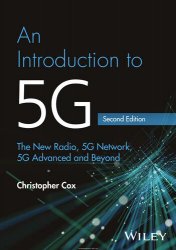An Introduction to 5G: The New Radio, 5G Network, 5G Advanced and Beyond, 2nd Edition
- Добавил: literator
- Дата: 9-05-2025, 01:33
- Комментариев: 0
 Название: An Introduction to 5G: The New Radio, 5G Network, 5G Advanced and Beyond, 2nd Edition
Название: An Introduction to 5G: The New Radio, 5G Network, 5G Advanced and Beyond, 2nd EditionАвтор: Christopher Cox
Издательство: Wiley
Год: 2025
Страниц: 527
Язык: английский
Формат: pdf (true), epub
Размер: 30.6 MB
A comprehensive and approachable introduction to 5G and 5G-Advanced.
Written by a noted expert on the subject, this Second Edition of An Introduction to 5G delivers a comprehensive, system-level guide to 5G and 5G-Advanced.
Building on the foundations laid in the First Edition, the topics explored include the market and use cases for 5G-Advanced; the architectures of the next generation radio access network, open radio access networks and the 5G core; the principles of radio transmission, millimeter waves and MIMO antennas; the architecture and operation of the 5G New Radio; the implementation of network function services by means of HTTP/2; and the signaling procedures that govern the end-to-end operation of the system.
This Second Edition has been thoroughly expanded and updated for 3GPP Release 18, to cover the new capabilities introduced under the name of 5G-Advanced. There are new chapters on:
The foundations of 5G-Advanced, including non-terrestrial networks, multicast/broadcast services, wireless backhauling, unlicensed spectrum, and artificial intelligence and machine learning
The Internet of Things, including time-sensitive communications, non-public networks, edge computing, and massive machine-type communications
Device-to-device communications on the 5G sidelink, in support of vehicle, aircraft and proximity-based services
The new features being introduced in 3GPP Release 19, and the expected applications, technologies and performance capabilities of 6G
The first few chapters cover the foundations. Chapter 1 reviews the history of mobile telecommunications and introduces the applications, requirements and key technical features of 5G. Chapter 2 covers the architecture of the core network and the signalling protocols that it uses, while Chapter 3 covers similar ground in the case of the radio access network.
The next three chapters address the underlying technologies that are used by the air interface. Chapter 4 reviews the use of radio spectrum and discusses the coverage issues that appear when operating at high radio frequencies. Chapter 5 reviews the techniques that are used for digital signal processing, for example modulation, demodulation, orthogonal frequency division multiple access and error correction. (Much of that chapter has been condensed from the author’s previous work, An Introduction to LTE.) Chapter 6 explains how 5G uses multiple antennas to compensate for the coverage problems that appear at high radio frequencies and to improve the system capacity when the radio frequency is low.
The next six chapters describe how the air interface is actually implemented. Chapter 7 is an introduction to the air interface, Chapter 8 describes the acquisition procedure in which a mobile discovers a nearby cell and Chapter 9 describes the random access procedure in which the mobile makes its initial communication. Chapter 10 covers the procedures for link adaptation, which compensate for changes in the amplitude and phase of the incoming radio signal, and help to control the use of multiple antennas. Chapter 11 addresses the procedures that are used for scheduling and data transmission, while Chapter 12 explains how the air interface’s higher-level protocols handle tasks such as scheduling and re-transmission.
...
The last four chapters address the enhancements that have been made to 5G in later releases of the specifications. Chapter 20 covers the general-purpose capabilities that form the foundations of 5G-Advanced, including location services, unlicensed spectrum, non-terrestrial networks, and artificial intelligence and machine learning. Chapter 21 focuses on system enhancements for the industrial internet of things and for massive machine-type communications. Chapter 22 addresses device-to-device communications on the 5G sidelink, as well as the vehicle, aircraft and proximity-based services that the sidelink helps to support. As the final topic, Chapter 23 reviews the enhancements that are planned for future releases of 5G and looks ahead to the introduction of a sixth generation of mobile telecommunications.
An Introduction to 5G is written for engineering professionals in mobile telecommunications, for those in non-technical roles such as management, marketing and intellectual property, and for students. It requires no more than a basic understanding of mobile communications, and includes detailed references to the underlying 3GPP specifications for 5G. The book’s approach provides a comprehensive, end-to-end overview of the 5G standard, which enables readers to move on with confidence to the more specialized texts and to the specifications themselves.
Скачать An Introduction to 5G: The New Radio, 5G Network, 5G Advanced and Beyond, 2nd Edition
Внимание
Уважаемый посетитель, Вы зашли на сайт как незарегистрированный пользователь.
Мы рекомендуем Вам зарегистрироваться либо войти на сайт под своим именем.
Уважаемый посетитель, Вы зашли на сайт как незарегистрированный пользователь.
Мы рекомендуем Вам зарегистрироваться либо войти на сайт под своим именем.
Информация
Посетители, находящиеся в группе Гости, не могут оставлять комментарии к данной публикации.
Посетители, находящиеся в группе Гости, не могут оставлять комментарии к данной публикации.
